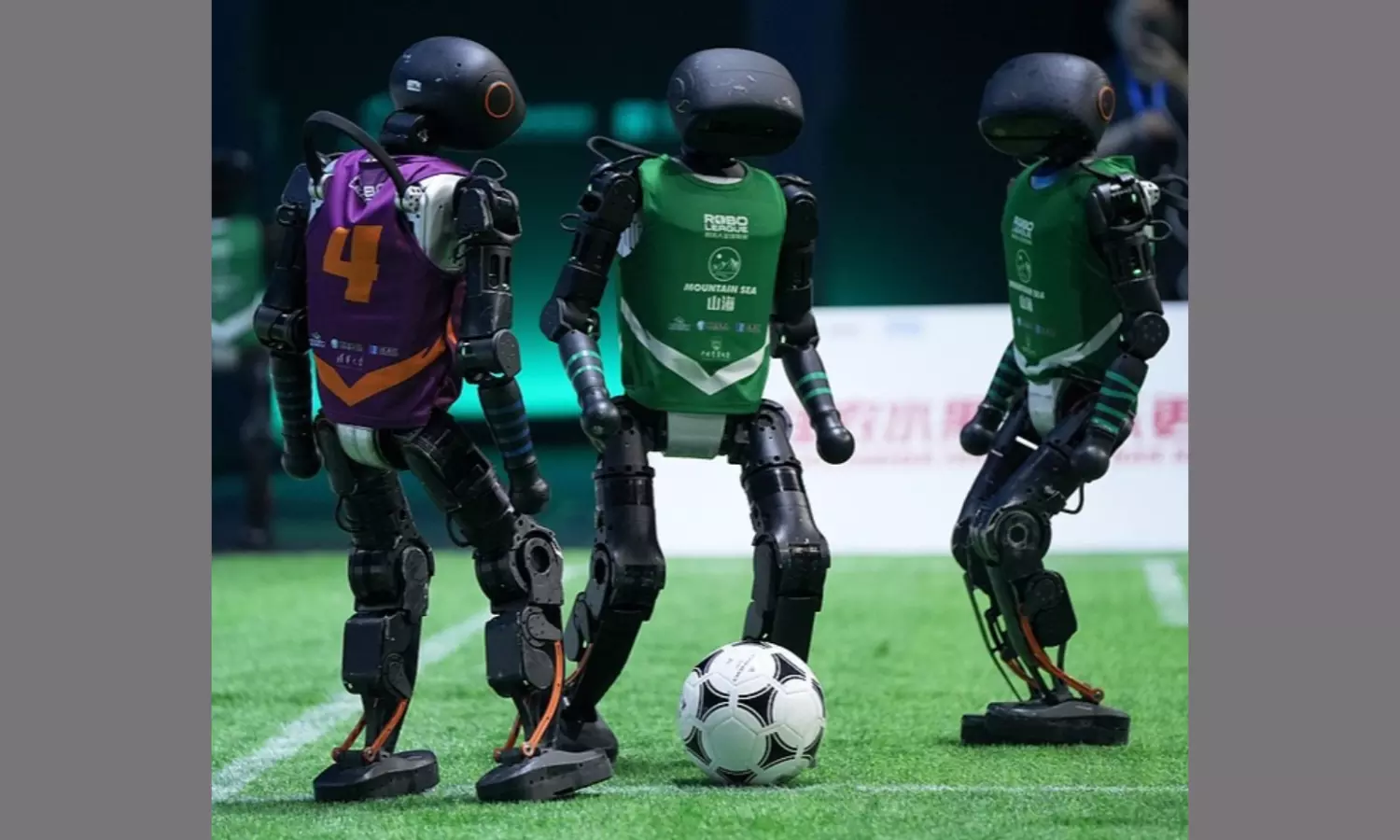When Robots Took the Field: AI-powered Humanoids Play Football in Beijing
Beijing hosted reportedly the world’s first fully autonomous football match between humanoid robots, marking a milestone in the development of embodied artificial intelligence.

In a remarkable blend of sport, science and spectacle, the world witnessed a unique football match in Beijing last evening, not between legendary strikers or rising rookies, but among AI-powered humanoid robots, each draped in colorful jerseys, sprinting, passing, and even celebrating goals like their human counterparts.
Beijing hosted reportedly the world’s first fully autonomous football match between humanoid robots, marking a milestone in the development of embodied artificial intelligence.
Held at the sprawling Beijing Institute of Technology stadium, the exhibition match was part of the city’s annual “Future Tech Sports Festival.” Drawing over 12,000 spectators — from schoolchildren clutching robot-themed flags to foreign researchers with notepads in hand — the event was less about competition and more a showcase of just how far robotics and artificial intelligence have come. More than metal and wires: These weren’t the clunky, slow-moving robots of old.
Roughly human-sized, standing at about 1.5 metres tall, they ran (or at least shuffled briskly) across the artificial turf, balancing on two legs, scanning the field with glowing camera-eyes, and plotting passes in real time. Each robot was equipped with an AI system that processed thousands of data points per second, from ball trajectory to the position of opponents and teammates, to decide its next move. Engineers from leading Chinese tech universities, along with invited teams from South Korea and Germany, had spent months training their robots to mimic football tactics: short passes, defensive marking, even the occasional backheel flick. And the effort showed in style.
At one point, a robot forward from the home team dribbled, clumsily, but undeniably, past two defenders before tapping the ball into the net, drawing cheers that echoed through the stadium. Technology meets entertainment The match lasted 40 minutes, split into two halves. The Beijing robots won 3–1 against their German- designed rivals, but the final score seemed to matter little.
Cameras followed every slip, save, and stumble, and social media in China buzzed with clips ad captions. Beyond entertainment, the exhibition had a deeper goal. These matches act as live testing grounds for robotics research, balance algorithms, machine vision systems, and multi-agent coordination models are all pushed to their limits on the pitch.
Cheng Hao, founder and CEO of Booster Robotics - The company behind the robot footballers who took the field on Saturday, described the tournament as far more than just a spectacle. In his view, every missed pass or successful tackle helps engineers refine complex algorithms and fine-tune the delicate balance between software and hardware. Sports give us the perfect testing ground,” Cheng told reporters after the match.
“Every move, every stumble, pushes our systems to get better and smarter.” Cheng also highlighted safety as a top priority, especially as the idea of robots sharing the field with human players edges closer to reality. “In the future, we might see robots playing side by side with humans,” he said.
“That’s why it’s so important to make sure they’re completely safe, a robot falling the wrong way could injure someone, and we have to prevent that.”
A nod to history While this may sound futuristic, robot football isn’t entirely new. The first RoboCup tournament, an international research competition, dates back to 1997. But what made last night’s match unique was the sheer realism and speed of play. Compared to early RoboCup games, where robots often spent more time toppling over than kicking, these new humanoids seemed surprisingly fluid. Li Boyang, CEO and Founder of Ex-Robots told in an previous interview at World Robot Conference,”We need a vivid robot in our lives, It can provide services to us as an chief servant in the family. credited advances in deep reinforcement learning, faster processors, and lighter materials.
“Five years ago, our robots could barely walk in a straight line,” he laughed.
“Now they run, they pass, they tackle — cautiously, but they tackle.” The Beijing Humanoid Robot Innovation Center announced groundbreaking news earlier: the world's first general embodied intelligence platform, "Hui Si Kai Wu", which features a "single brain with multiple functionalities" and the ability to support multiple robots operating, officially made its debut.
With the support of this platform, humanoid robots are poised to evolve from executing singular tasks to making autonomous decisions and executing tasks in complex environments. At the unveiling ceremony, robots equipped with the platform demonstrated their capabilities of industrial sorting, block building, desk clearing, and logistics packaging. Ethical questions and the road ahead Not everyone is entirely comfortable with the rise of such advanced humanoids. Critics worry about AI used in military applications, or the risk of automation replacing human jobs, even in sport.
For now, though, the crowd seemed more charmed than concerned. Reportedly, China has some truly ambitious plans. As early as next year, the festival could see mixed teams of humans and robots playing side by side, something that would have sounded like pure science fiction just ten years ago.
Backed by a clear roadmap for 2025 and 2027, China aims to tackle the toughest challenges in humanoid robotics and sharpen its core technologies. It’s a strategic push to keep the country firmly in the lead on the global robotics stage.
This article is authored by Uday Raj Singh as part of internship program with Deccan Chronicle

